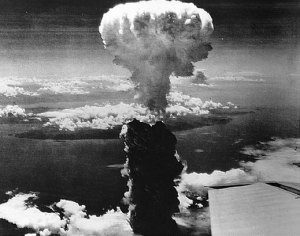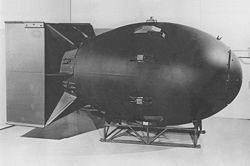August 7, 2008 – by Barry Cauchon.
August 6 – 9 marks the 63rd anniversary of the bombing of Japan with two atomic bombs which effectively ended the Pacific War and World War II between the Japanese and the Allies.
When the United States made the decision to drop the atomic bomb on Hiroshima, Japan on Monday, August 6, 1945, the hope was that this action would end the war. The bomb, nicknamed “Little Boy”, was dropped by the B-29 Superfortress bomber Enola Gay. And although it took a second atomic bomb to force Japan to surrender, the Enola Gay’s name has gone down in history as the plane that was responsible for ending WWII.
But the crew of the Enola Gay only dropped the first bomb. Three days later, on Thursday, August 9, a second atomic bomb, this one nicknamed “Fat Man” was dropped on Nagasaki. The B-29 that delivered this, the final blow to the Japanese, was known as Bockscar.
Bockscar was part of the same squadron as the Enola Gay, the 393d Bombardment Squadron, Heavy, of the 509th Composite Group (USAAF). It was named after its commander Captain Frederick C. Bock who, along with his crew C-13, participated in several bombing runs on Japan prior to the events that occurred in early August, 1945.
STRANGE TWIST OF FATE #1
Originally, The Great Artiste commanded by Major Charles W. Sweeney was the plane scheduled to drop the second atomic bomb. Sweeney and his crew C-15 had previously flown The Great Artiste with the Enola Gay on her flight to Hiroshima on August 6, carrying instrumentation to record and support the mission. Upon their return Sweeney and his crew began to prepare for their turn. The next mission was planned for August 11 but due to a poor weather forecast, the commanders decided to move the attack up by two days, setting a new date of August 9. Sweeney and his crew had been doing training runs in Captain Bock’s plane Bockscar while The Great Artiste was to have its instruments removed and installed in another plane. However, when the mission date moved forward, it did not give the ground crews enough time to do the transfer, so it was decided that Sweeney and Bock would switch planes. Hence, Bock and his crew flew The Great Artiste in a support role on the mission and Sweeney and his crew, aboard Bockscar, became the primary unit to drop the second atomic bomb on Japan.
STRANGE TWIST OF FATE #2
The primary target for the August 9 bombing mission was the industrial city of Kokura. However, when the Bockscar arrived over the city with Fat Man ready to be deployed, the crew found that visibility over the city was obscured by clouds and smog. Sweeney’s orders were specific in that the atomic bomb had to be dropped visually on the target. Failing to spot their target after passing over Kokura three times, Sweeney decided to proceed to the secondary target of Nagasaki. At 11:02am, Fat Man, the atomic bomb with 14.1 lbs of plutonium-239, was dropped. The bomb detonated about 43 seconds later at an altitude of about 1,540 feet above the ground. Approximately 40% of Nagasaki was destroyed.
Although Fat Man was considered a more powerful bomb than Little Boy, the hilly terrain helped to deaden the destruction whereas Hiroshima was flat and open and thus suffered much greater devastation. What twist of fate saved the people of Kokura and yet doomed so many citizens of Nagasaki?
It’s also known that many survivors of the Hiroshima bombing made their way to Nagasaki only to experience the second terrifying explosion all over again. Many of them did not survive the second time.
AFTERMATH
The overall death toll from these attacks was astounding. Not only did people die from the initial bomb blasts, but later died from burns, injuries or radiation poisoning. In Hiroshima, a city estimated with a population of about 350,000 people, over 70,000 died in the blast itself with estimates ranging from 70,000 to 130,000 potentially dying within the next 5 years. In Nagasaki, a city of 270,000 citizens, approximately 70,000 people died by the end of 1945.
It is hard for us, in this day of global cooperation and unity, to imagine how such destructive acts could have been implemented. But 63 years ago, a bitter war was raging and no mercy could be shown to the enemy, especially when the memories of Pearl Harbor were still so fresh in people’s minds. The Bockscar and her crew were part of this history, whether morally right or wrong. She did the job she was sent out to do and accomplished her mission. But history has almost forgotten her involvement and the Enola Gay still takes the spotlight.
Forgotten (by the masses), but not gone, the Bockscar lives on to this day.
In 1961, Bockscar was restored and put on permanent display at the National Museum of the United States Air Force Museum at Wrights-Patterson Air Force Base in Dayton, Ohio. Signage near the plane states “The aircraft that ended WWII”. Never has a statement been more true. But alas, the notoriety for dropping the atomic bomb that ended the war still goes to her sister ship, the famous Enola Gay.
This link will take you to the National Museum of the United States Air Force Museum. Hit it and type in Bockscar in the search bar.
http://www.nationalmuseum.af.mil/
Here is the list of the 13 airmen who flew on the Bockscar on that historic mission 63 years ago and truly, ended World War II.

- The crew of the Bockscar. Front row: Buckley, Kuharek, Gallagher, Dehart, Spitzer. Back row: Beahan, Van Pelt, Jr., Albury, Olivi, Sweeney.
Crew C-15 of the Bockscar
- Major Charles Sweeney, Commander
- Captain Charles Donald Albury, Co-Pilot
- 2nd Lieutenant Fred Olivi, Third Pilot
- Captain James Van Pelt, Jr., Navigator
- Captain Raymond “Kermit” Beahan, Bombardier
- Master Sergeant John Kuharek, Flight Engineer
- Sergeant Raymond Gallagher, Assistant Flight Engineer
- Staff Sergeant Ed Buckley, Radar Operator
- Sergeant Abe Spitzer, Radio Operator
- Staff Sergeant Albert Dehart, Tail Gunner
Additional Mission Crew on board August 9, 1945
- Cmdr. Frederick L. Ashworth (USN), Weaponeer
- Lt. Philip Barnes (USN), Assistant Weaponeer
- 2nd Lt. Jacob Beser, Radar Countermeasures
—————————————————————————-
“AN AWESOMETALK WITH”
Be sure to read “An Awesometalk With” ROBERT KRAUSS, 509TH COMPOSITE GROUP HISTORIAN. This was an interview I did with Mr. Krauss and it will give you a really great insight into the 509th and the men that participated in the group and their missions.
Also, take a look at Mr. Krauss’ book “The 509th Remembered” which you can find on his website at www.enolagay509th.com . If you do order one, please tell him that you saw it here so he can track where people are hearing about his book.

—————————————————————————-
Best
Barry




